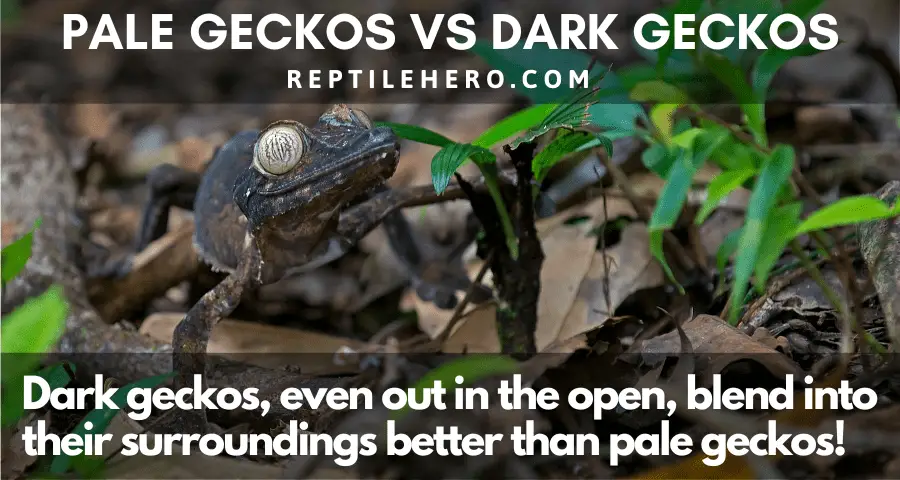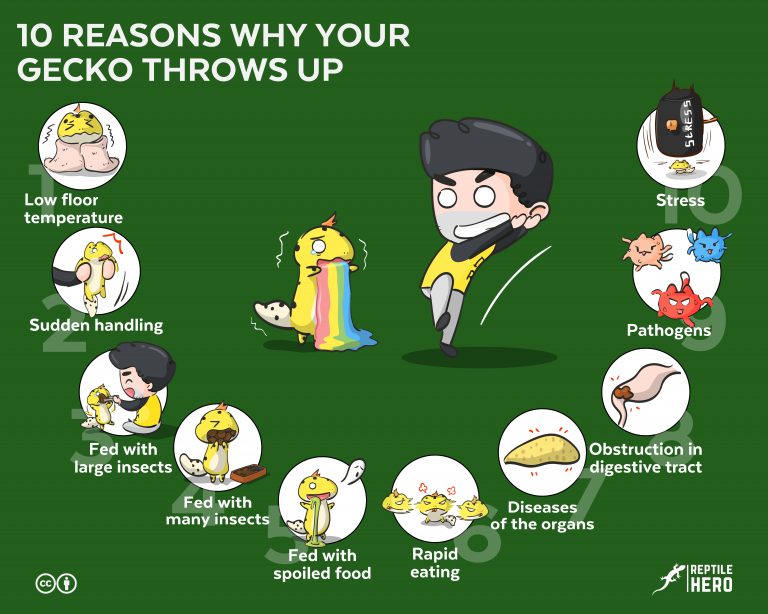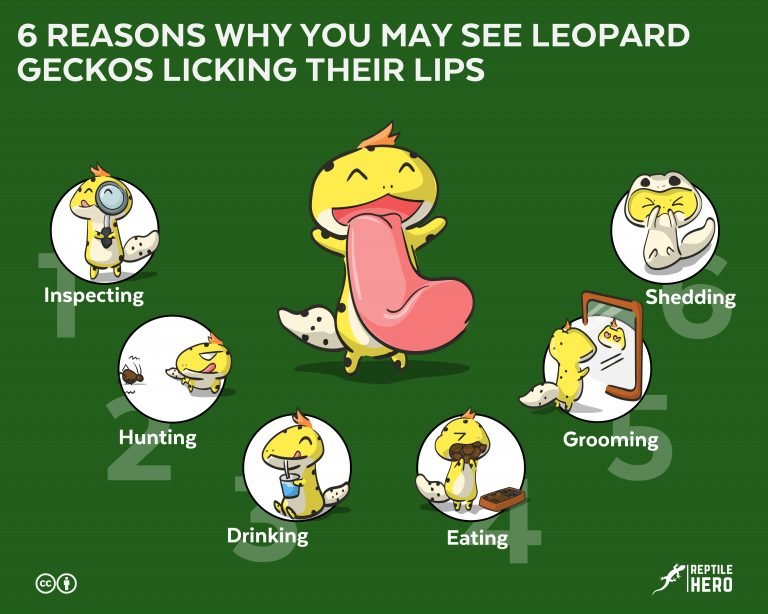7 Reasons Why Your Gecko Is Pale? (From Science)
Noticing how pale your first-ever pet gecko has become can be quite scary, especially since it’s mostly a bad sign for humans. But geckos don’t exactly have the same reasons behind becoming pale and dull as we do. Some scientists even believe a gecko feels safe and comfortable when its colors become drab and ashy!
Overall, geckos can get pale because of regular shedding, thermoregulation, and camouflage. Geckos can also be naturally pale. All of these reasons are natural and harmless. Some experts also believe that geckos can become pale due to relaxed mood, incomplete diet, and diseases like Cryptosporidiosis.
Similar to chameleons, geckos can change their colors—just to a much more limited degree. However, the reasons behind such changes are not yet fully explored. Read on to find out the known and theorized causes of paling in geckos!
1. Natural Coloration
Like humans and other animals, geckos may be naturally pale in color due to genetics. Morphs such as blizzard leopard geckos and lilly white crested geckos, for instance, are famous for their characteristically and naturally light-colored bodies.
Simply put, some geckos have lighter colors and more subdued patterns than others. This is true for wild specimens, but there are more striking in captive-bred geckos due to selective line breeding to reproduce beautiful morphs.
Albino morphs, more specifically, were bred so that they have very little black pigments [1]. However, this does not make them completely white. They typically still have hints of color—light lavenders, browns, and tans.
| Species | Leopard Gecko | Crested Gecko |
| Morph | Blizzard Dreamsicle White Knight Diablo Blanco Bell Albino Rainwater Albino Tremper Albino | Moonglow Lilly White High White Creamsicle Cream On Cream Lavender Super Dalmatian |
Discover what vibrant and bold colors and patterns there are in our article on gecko morphs 101.
However, what most newbie owners aren’t aware of is that a gecko can change its color as it grows. So a young gecko with pretty dark colors can mature into muted-colored geckos that are beautiful regardless.
Personally, I know first-time gecko owners who get bright orange or dark red baby cresties then end up with much paler geckos. The color change doesn’t happen instantaneously so commonly takes them a few weeks or months to notice anything at all.
As a general rule, you won’t know what a gecko’s permanent color will be until after it turns 1 year old.
Conversely, relatively light-colored baby geckos can also grow up to have striking lines, spots, and coloration. Either way, a gradual change in a gecko’s coloration and patterning is completely normal!
The Only Bad Pale-Colored Gecko Morph
A few years back—around 2015—a new and stunning morph was introduced to the gecko-keeping community. It was a leopard gecko with a bold white and yellow coloration, so the morph was named Lemon Frost. It was rare and new so it racked up high prices.
Sadly, as time went on Lemon Frost leo owners noticed very troubling bumps all around their small bodies. As it turns out, the very cells giving them their bright white pigmentation is also producing very dangerous tumor in their bodies.
2. Regular Shedding
Even dark-colored geckos like the Chinese cave gecko regularly turn pale due to their shedding cycle. Once successfully completed though, geckos will regain their natural coloration—be it normally light, dark, or colorful.
A gecko’s whole body will take on a white tint right before it sheds its old skin, from the crown of its snout to the tip of its tail. Each toe and/or crest of a gecko undergoing its shed cycle will also take on a lighter ashy shade.
This sudden paling is often quite noticeable, especially right before a gecko tries to get rid of its shed. But it is nothing to worry about it.
Honestly, I’d be more worried if a gecko never sheds. But just cause you haven’t seen them do it doesn’t necessarily mean they never do.
Many of my friends only ever saw their geckos shed after installing cameras in their gecko rooms and tanks. So consider getting one yourself if you want to see your scaly babies in action!
Find out our recommendations in our article on the best cameras for gecko tanks.
How Do You Ensure Successful Shedding in Geckos?
To ensure successful shedding in geckos, they must always have access to clean fresh water in their tank as well as a humid hide. By the end of their shedding cycles, the humidity can be temporarily boosted to 60–80% to allow for easy and painless shedding. In other words, geckos must be kept well-hydrated to ensure a good shed.
Otherwise, they may suffer from chronic shedding problems and the complications which may result from it. This includes bloody noses and lost toes.
3. Thermoregulation
Some gecko species tend to turn pale when it gets too hot during the day and to avoid losing body heat during the night. This has been observed in various species, including Moorish geckos, in the wild and captivity. They can change in color depending on the availability of light and heat.
Just like chameleons—who are famous for their astonishing color-changing abilities—geckos can also change their colors as well. They can do so using the cells in their skins that contain pigments which are called chromatophores.
But unlike these colorful lizards, our geckos have a much more limited color range they can transition into—mostly just from dark to pale and vice versa.
Though such constrictions may make their color-changing abilities seem inconsequential, it’s actually quite useful for our cute little geckos! Especially since they are heavily reliant on their environments for changing and maintaining their preferred body temperatures.
When geckos go dark, they usually do it to absorb more heat [2]. Conversely, geckos intentionally become pale when they feel warm enough so that they don’t end up burning themselves to a crisp under direct sunlight or strong heat lamps like halogens.
Simply put, geckos turn pale or dark to thermoregulate. In fact, changing color is one of the few ways reptiles are able to control their body temperatures as “cold-blooded” animals.
So if you notice that you’re gecko’s almost always going pale, even during the day, I suggest you closely check the temperature in its tank. Why? Because there’s a high chance that it could be overheating!
Pro Tip: Use both a temp gun and an ambient thermometer for accurate readings in gecko tanks.
4. Camouflage
Despite not being able to perfectly camouflage with their surroundings, Mediterranean geckos and tokay geckos—and many other species—can deliberately lighten or darken themselves to blend into their environment. This is mainly done to avoid getting noticed by potential predators.
This is actually one of the most common reasons people think of when they are asked to guess why geckos go pale or dark—well, at least in my experience.
Usually, they use the color of the substrate they are standing on or the wall they are sticking to as their point of reference when changing color. Mediterranean geckos, for instance, turn pale pink with light backgrounds and turn deep brown with dark backgrounds [3].
Tokays also do the same thing. They not only lighten or darken their base color but also their spotting!
Doing so allows them to disguise themselves and hide from the prying eyes of predators such as birds and bigger mammals.
Blending In: Pale Geckos vs Dark Geckos
What I was really surprised to learn was that naturally dark-colored geckos are much better at changing their bodies’ colors than light-colored geckos.
Frankly, I thought there wouldn’t be any difference between their abilities! But scientists say otherwise.

As it turns out, dark geckos which are active during the day not only have more melanin in their skins which they can manipulate. They also have more hormones responsible for triggering such color changes [4]!
This allows diurnal gecko species to better match a wide variety of substrates and materials in their homes.
4. Relaxed Mood
Some scientists and experienced gecko owners note that geckos commonly become pale after they have acclimated. As such, they believe that the lightening of a gargoyle gecko’s coloration, for instance, is a sign of it being relaxed and comfortable.
This is actually the idea behind the terms “fired down” and “fired up.” Both of these are used not only for common pet geckos like gargoyle geckos but also for many other familiar reptiles such as bearded dragons.
When a gecko is neither stressed nor excited and just plainly at rest, it will most likely sport a relatively drab and dull color. Here it is fired down.
But once it feels heightened emotions, be it stress or excitement, its colors generally deepen and become more vivid. Hence, the term fired up.
Admittedly, though, this reason is more of a theory than a proven reason behind why geckos turn pale. Nevertheless, I think that there may be some merit to the belief that mood can facilitate color changing in geckos.
One study, in particular, has shown that rapid color changes in geckos, like the Trinidad gecko and the large-scaled chameleon gecko, can be triggered by neural and hormonal stimulation [5].
Interestingly, however, some female gecko species are said to be incapable of changing their colors.
Changing Colors Due to Mood? Even When They Don’t Have Emotions?
Some gecko keepers and breeders disagree with the hypothesis that geckos become pale when relaxed. This is largely due to the fact that they don’t believe that geckos—let alone any other reptile—are capable of feeling any emotional state.
But recent studies actually prove otherwise—they even get bored! Moreover, geckos are a lot smarter than most people give them credit for. So it makes sense that they are sentient enough to experience a myriad of moods and emotions.
6. Incomplete Diet
Dulling and graying of geckos, such as the leachianus gecko, is believed to be a result of inadequate diets. When a gecko is pale, it may not be receiving enough vitamins, minerals, and many other macronutrients such as protein and fat.
Honestly, I’m still on the fence about this reason but I know several experienced owners and breeders who believe that a gecko’s diet can affect its color.
I mean, sure, certain food items are rich in compounds that are known to enhance color in some animals—beta-carotene for yellows and reds and anthocyanin for blues and purples [6].
But I have yet to find an actual experiment comparing the colors of geckos on different diets. As a matter of fact, a few years ago one company even released a supposedly “color enhancing” powder diet for frugivorous species such as mourning and leachie geckos.
I remember seeing their packaging and noticing nothing special in their ingredients list so I was quite doubtful. I also asked my friends about their thoughts on it but they all gave mixed reviews.
A few swear that their pale geckos developed brighter and more vivid coloration after eating it. In contrast, others simply say that their precious geckos seemed to like it but their colors and patterns didn’t change whatsoever.
The only research study I ever found on an animal’s diet’s effect on its color that could be applied to geckos was done on frogs. In this research, the results were inconclusive as well [7].
7. Serious Illness
Oftentimes, geckos may also become markedly pale and display other abnormal behaviors such as lethargy and anorexia when they become sick. Such illnesses can vary in severity, from dehydration to Cryptosporidiosis.
A dehydrated gecko may develop dry white patches of skin in different parts of its body. This is quite similar to what we humans experience when we don’t get enough hydration.
When left unaddressed, a dehydrated gecko may also struggle with shedding issues and eventually die. This is why experts recommend always providing geckos with clean drinking and soaking water in their tanks which they can freely access when they need to.
Besides dehydration, I have also noticed that geckos dealing with serious parasites like Cryptosporidium varanii become incredibly dull-colored as the infection progresses.
So it’s always advisable to practice good hygiene and up-to-date husbandry practices to minimize, if not completely eliminate, the chances of your lovely gecko getting sick.
In the unfortunate event that your pale gecko does get sick and it dies before you can take it to a vet, try ordering a reptile necropsy instead. Doing this will help you understand what illness your gecko suffered from, what are the possible causes, and preventive measures. It could serve as a learning experience for you and other gecko owners.

However, it is still uncertain if all serious diseases will result in geckos becoming pale, especially because geckos can also deliberately lighten their skin for their own advantage—as I have discussed previously.
Further Questions
Why do a gecko’s eyes look cloudy?
When a gecko is preparing to shed, all parts of its body may take on a cloudy appearance including its eyes and ears. However, if a gecko has cloudy eyes even after it has finished shedding, it may have eye problems due to bacterial infections and the like.
Is it normal for a gecko’s toes to start turning black?
Unless a gecko’s toes were black in color, to begin with, it is generally not normal for a specific patch of its body to suddenly turn black. When parts of a gecko’s body turn black, it is likely necrotizing or dying. This may happen when multiple stuck shed accumulates on a gecko’s toes, cutting off circulation in the area.
What colors do geckos naturally have?
More often than not geckos are naturally brown or gray in color with some white, pink, yellow, orange, and black markings. However, some species are famous for being brightly colored—with greens, blues, reds, and even gold. Such colorful species include day geckos and other Phelsuma geckos.
Summary of Why is Your Gecko Pale?
A gecko becoming pale is not necessarily a sign of danger or bad health. Rather, it is normal for geckos to take on a lighter, sometimes even dull, coloration for natural reasons which may play a role in ensuring their survival.
More specifically, geckos commonly take on a white or gray shade due to their morphological coloration, regular shedding cycle, efficient thermoregulatory behavior, and effective camouflaging.
Others also theorize that a gecko may become pale and dull because they are relaxed and comfortable, being sustained by incomplete diets, or due to serious illness. As such, an experienced exotic veterinarian should determine whether or not a gecko’s pale coloration is a cause of concern.
Sources
[3] https://scholarworks.utrgv.edu/cgi/viewcontent.cgi?article=1095&context=bio_fac
[4] https://www.ncbi.nlm.nih.gov/pmc/articles/PMC6361904/
[5] https://www.press.jhu.edu/newsroom/wild-thing-qa-geckos-animal-answer-guide

![Do Geckos Fart? [4 Potential Reasons]](https://www.reptilehero.com/wp-content/uploads/2021/05/why-geckos-fart-cc-768x614.jpg)
![Keep Your Gecko Safe From Your Cat – Ultimate Guide [Set-Ups]](https://www.reptilehero.com/wp-content/uploads/2021/11/Gecko-safe-from-cat-cc-1-768x614.jpg)




